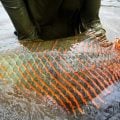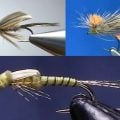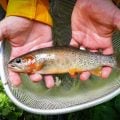How to Tie the Plastic Surgeon
Producer: tightlinevideo
I call this fly the Plastic Surgeon, mainly because there isn’t a single natural material on it. That said, it’s a true guide fly—fairly cheap and quick to tie, all but bulletproof and, of course, extremely effective. I do have to thank friend and fellow New Jersey fly tier John Collins for the idea of using faux bucktail for the tail, as it really helped to bring this pattern together.
The Plastic Surgeon starts with a Fulling Mill 5045 size 14 jig hook. After getting the hook secured in plunger-style hackle pliers, I’ll set it aside. The hook is matched with a black 7/64” slotted tungsten bead. I like to stab a single bead with my bodkin in order to pick it up and center the small hole in my fingertips. This makes it easy to insert the point of the hook into that small hole, then bring the bead around onto the hook shank. Next, I’ll get the assembly firmly secured in the jaws of my tying vise.
For thread, I’ve loaded a bobbin with a spool of black UTC 70 Denier. Get the thread started on the hook shank, behind the bead and, after taking a few rearward wraps, wrap back up to the bead and snip the excess tag end off close.
.02 lead-free wire is used to add weight, help stabilize the bead and give some taper to the body of the fly. With the spool in hand, insert the bitter end of the wire into the slot on the back of the bead, then use tight thread wraps to anchor it there. Make 5 or 6 rearward turns with the wire, behind your tying thread, before helicoptering to break the excess off close. Take thread wraps to further anchor the wire and to start building a ramp down to the bare hook shank. End with your tying thread hanging at about the hook point.
Three different colors of faux bucktail are used to create the tail and body of the fly. Here, I’m going to use bright orange for the tail. Separate out 8 or so fibers from the clump and pull them free. Snip a 2” segment of the tip ends off and place them, tips first, into a small stacker then give them a gentle stacking. Retrieve the fibers from the stacker with the tips pointing toward the rear of the fly. Measure to form a short tail, just a little more than a hook gap in length. Use your tying scissors to trim the excess butt ends off even with the back edge of the bead. Begin binding the fibers to the top of the hook shank with tight wraps of tying thread. Go all the way back to the start of the hook bend then continue taking thread wraps to build up a nicely tapered underbody on the fly. End with your thread at the back edge of the wire wraps.
Now, pull off two or three strands of the black faux bucktail and an equal number of green strands. Lay them together then snip the butt ends off square. Place the ends on top of the hook shank at the back edge of the bead and begin taking thread wraps to secure them. Continue taking thread wraps rearward, binding the fibers to the top of the hook shank, all the way back to the base of the tail. Pull the fibers up and begin taking forward, touching wraps with them behind your tying thread. Don’t worry if the color sequence doesn’t look exactly like this, everything, including a little overlapping of fibers will work just fine. At the back edge of the bead, secure the material with tight wraps of tying thread then snip the excess off close.
Pick up your head cement or here, Sally Hansen Hard as Nails, and apply a drop or two to the body of the fly. Then use your bodkin to spread it out evenly. There’s no need to let it dry before moving on to the next step.
Black peacock Ice Dub is used for the thorax of the fly, the smallest wisp is all you need. Use the dubbing to create a short, thin noodle on your tying thread, then take wraps with the noodle to build up a compact, little collar on the fly.
Reach for your whip finish tool and use it to do a 4 or 5 turn whip finish. Be sure to seat the knot well and snip or cut your tying thread free. Once again, pick up your head cement or Sally Hansen’s and, this time, use it to coat the bare thread wraps at the back edge of the bead.
And that’s the super simple and extremely durable Plastic Surgeon, ready to operate. As you can imagine, mixing and matching different colors of faux bucktail along with different colors of Ice Dub and even different colored beads, will result in a staggering number of color combinations. As with plastic surgery in general, some efforts will look better than others.
How to Tie the Pine Squirrel Streamer
How to Tie the PMD Trigger Point Usual











